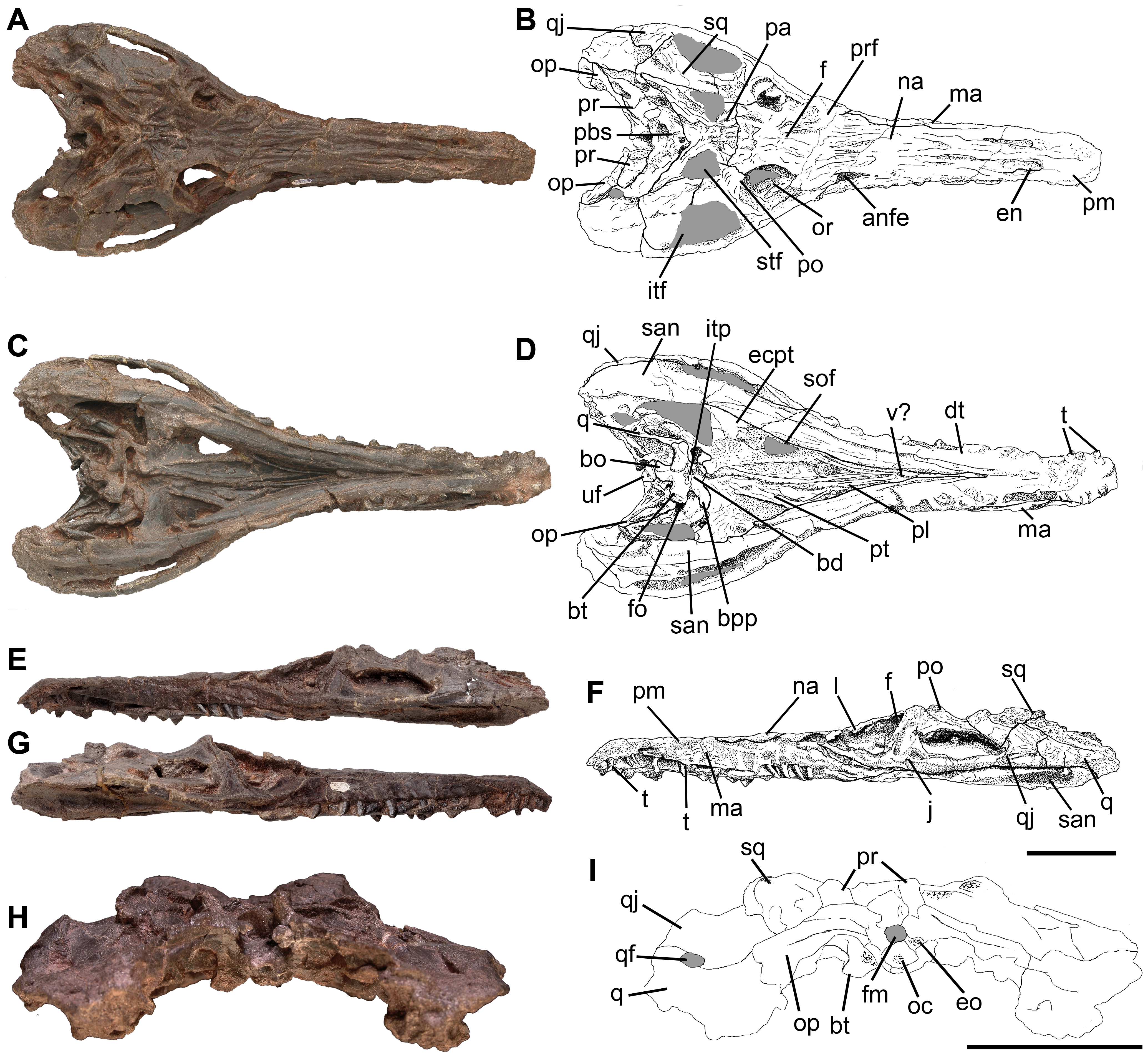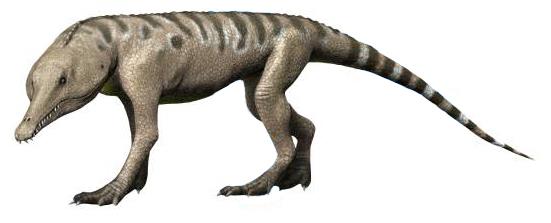|
Proterochampsidae
Proterochampsidae is a family of proterochampsian archosauriforms. Proterochampsids may have filled an ecological niche similar to modern crocodiles, and had a general crocodile-like appearance. They lived in what is now South America in the Middle and Late Triassic. Description Proterochampsids have long, crocodile-like skulls. The posterior portion of the skull is wide while the snout is very narrow. Most proterochampsids also have downturned snouts. Like many early archosauriforms, they also have dermal armour. Proterochampsids have small holes called dorsal fenestrae at the top of their skulls. Unlike other early archosauromorphs, they do not have a parietal foramin, which in many reptiles holds a parietal eye. The postorbital bones behind the eye sockets have thick, jagged crests. As another diagnostic feature of the group, the holes that allow the passage of the internal carotid artery through the braincase open at the sides of a bony projection called the basipterygoid p ... [...More Info...] [...Related Items...] OR: [Wikipedia] [Google] [Baidu] |
Proterochampsia
Proterochampsia is a clade of early archosauriform reptiles from the Triassic period. It includes the Proterochampsidae (e.g. '' Proterochampsa'', '' Chanaresuchus'' and '' Tropidosuchus'') and probably also the Doswelliidae. Nesbitt (2011) defines Proterochampsia as a stem-based taxon that includes '' Proterochampsa'' and all forms more closely related to it than ''Euparkeria'', ''Erythrosuchus'', ''Passer domesticus'' (the House Sparrow), or ''Crocodylus niloticus'' (the Nile crocodile). Therefore, the inclusion of Doswelliidae in it is dependent upon whether ''Doswellia'' and '' Proterochampsa'' form a monophyletic group to the exclusion of Archosauria and other related groups. Description Nesbitt (2011) found that Proterochampsians share several distinguishing characteristics, or synapomorphies. A prominent ridge runs along the length of the jugal, a bone below the eye. Another ridge is present on the quadratojugal, a bone positioned toward the back of the skull behind the j ... [...More Info...] [...Related Items...] OR: [Wikipedia] [Google] [Baidu] |
Archosaur
Archosauria () is a clade of diapsids, with birds and crocodilians as the only living representatives. Archosaurs are broadly classified as reptiles, in the cladistic sense of the term which includes birds. Extinct archosaurs include non-avian dinosaurs, pterosaurs, and extinct relatives of crocodilians. Modern paleontologists define Archosauria as a crown group that includes the most recent common ancestor of living birds and crocodilians, and all of its descendants. The base of Archosauria splits into two clades: Pseudosuchia, which includes crocodilians and their extinct relatives, and Avemetatarsalia, which includes birds and their extinct relatives (such as non-avian dinosaurs and pterosaurs). Older definitions of the group Archosauria rely on shared morphological characteristics, such as an antorbital fenestra in the skull, serrated teeth, and an upright stance. Some extinct reptiles, such as proterosuchids and euparkeriids, possessed these features yet originated pri ... [...More Info...] [...Related Items...] OR: [Wikipedia] [Google] [Baidu] |
Pseudochampsa
''Pseudochampsa'' is an extinct genus of proterochampsid archosauriform known from the Late Triassic (Carnian) Cancha de Bochas Member of the Ischigualasto Formation of San Juan Province, Ischigualasto-Villa Unión Basin in northwestern Argentina. It contains a single species, ''Pseudochampsa ischigualastensis'', originally named as a second species of the closely related '' Chanaresuchus'', based on a fairly complete articulated skeleton and skull.Trotteyn et al., 2012 A revision of the remains concluded that it was best to move to species to its own genus, as no traits were found to unite ''P. ischigualastensis'' and the type species of ''Chanaresuchus'' to the exclusion of other proterochampsids. A phylogenetic analysis places both species in a polytomy with '' Gualosuchus'' as the most advanced members of Proterochampsia.Trotteyn & Ezcurra, 2014 Discovery ''Pseudochampsa'' is known solely from the holotype PVSJ 567, a nearly complete and articulated individual ... [...More Info...] [...Related Items...] OR: [Wikipedia] [Google] [Baidu] |
Archosauriform
Archosauriformes (Greek for 'ruling lizards', and Latin for 'form') is a clade of diapsid reptiles that developed from archosauromorph ancestors some time in the Latest Permian (roughly 252 million years ago). It was defined by Jacques Gauthier (1994) as the clade stemming from the last common ancestor of Proterosuchidae and Archosauria (the group that contains crocodiles, pterosaurs and dinosaurs bird.html"_;"title="ncluding_bird">ncluding_birds;_Phil_Senter.html" ;"title="bird">ncluding_birds.html" ;"title="bird.html" ;"title="ncluding bird">ncluding birds">bird.html" ;"title="ncluding bird">ncluding birds; Phil Senter">bird">ncluding_birds.html" ;"title="bird.html" ;"title="ncluding bird">ncluding birds">bird.html" ;"title="ncluding bird">ncluding birds; Phil Senter (2005) defined it as the most exclusive clade containing ''Proterosuchus'' and Archosauria. These reptiles, which include members of the family Proterosuchidae and more advanced forms, were originally superficiall ... [...More Info...] [...Related Items...] OR: [Wikipedia] [Google] [Baidu] |
Stenoscelida
''Stenoscelida'' (meaning "narrow hind leg") is a genus of proterochampsid archosauriforms from the Late Triassic Santa Maria Supersequence ( Paraná Basin) of Rio Grande do Sul, Brazil. The genus contains a single species, ''S. aurantiacus'', known from a right hind limb. Discovery and naming The holotype specimen, CAPPA/UFSM 0293, was found at the '' Exaeretodon'' sub-Assemblage Zone (''Hyperodapedon'' Assemblage Zone) of the Santa Maria Supersequence (lower Candelaria Sequence) in the Paraná Basin. This locality is dated to the late Carnian/early Norian ages of the upper Triassic period, around 228 million years old. It consists of a complete, articulated right hind limb. In 2022, ''Stenoscelida aurantiacus'' was described as a new genus and species of proterochampsid archosauriforms by Rodrigo T. Müller, Mauricio S. Garcia, and André O. Fonseca based on these remains. The generic name, "''Stenoscelida ''", is derived from the Greek words " στενός", meaning "n ... [...More Info...] [...Related Items...] OR: [Wikipedia] [Google] [Baidu] |
Tropidosuchus
''Tropidosuchus'' is an extinct genus of carnivorous archosauriforms from the Middle Triassic period (Anisian to Ladinian stage). It is a proterochampsid which lived in what is now Argentina. It is known from the holotype PVL 4601, which consists of partial skeleton. It was found in the Chañares Formation and its type locality is the Chañares River. It was first named by A. B. Arcucci in 1990 and the type species In zoological nomenclature, a type species (''species typica'') is the species name with which the name of a genus or subgenus is considered to be permanently taxonomically associated, i.e., the species that contains the biological type specimen ... is ''Tropidosuchus romeri''. References Proterochampsians Ladinian genera Middle Triassic reptiles of South America Triassic Argentina Fossils of Argentina Chañares Formation Fossil taxa described in 1990 Prehistoric reptile genera {{triassic-reptile-stub ... [...More Info...] [...Related Items...] OR: [Wikipedia] [Google] [Baidu] |
Chanaresuchus
''Chanaresuchus'' is an extinct genus of proterochampsian archosauriform. It was of modest size for a proterochampsian, being on average just over a meter in length. Fossils are known from the Middle and Late Triassic of La Rioja Province, Argentina and Rio Grande do Sul (geoparque Paleorrota), Brazil. The type species and only currently known species is ''Chanaresuchus bonapartei'' was named from the Ladinian-age Chañares Formation in 1971. A second species ''C. ischigualastensis'' named in 2012 from the late Carnian-age Ischigualasto Formation, was briefly assigned to ''Chanaresuchus'' before being moved to its own genus '' Pseudochampsa'' in 2014. ''C. bonapartei'' has recently been found in the Carnian Santa Maria Formation in Brazil. ''Chanaresuchus'' appears to be one of the most common archosauriforms from the Chanares Formation due to the abundance of specimens referred to the genus. Much of the material has been found by the La Plata-Harvard expedition of 1964-65. ''Cha ... [...More Info...] [...Related Items...] OR: [Wikipedia] [Google] [Baidu] |
Proterochampsa
''Proterochampsa'' is a genus of proterochampsid archosauromorph from the Late Triassic (Carnian) Cancha de Bochas Member of the Ischigualasto Formation in the Ischigualasto-Villa Unión Basin in northwestern Argentina and the Alemoa Member of the Santa Maria Formation in the Paraná Basin in southeastern Brazil Brazil ( pt, Brasil; ), officially the Federative Republic of Brazil (Portuguese: ), is the largest country in both South America and Latin America. At and with over 217 million people, Brazil is the world's fifth-largest country by area .... Average length of skull of ''P. barrionuevoi'' is approximately . References Further reading * F. Abdala, M. C. Barberena, and J. Dornelles. 2002. A new species of the traversodontid cynodont Exaeretodon from the Santa Maria Formation (Middle/Late Triassic) of southern Brazil. Journal of Vertebrate Paleontology 22(2):313-325 * * O. A. Reig. 1963. La presencia de dinosaurios saurisquios en los "Estratos de Ischig ... [...More Info...] [...Related Items...] OR: [Wikipedia] [Google] [Baidu] |
Cerritosaurus
''Cerritosaurus'' is a genus of proterochampsid archosauromorph from the Late Triassic. It has been found in the Santa Maria Formation, in the Geopark of Paleorrota, Brazil Brazil ( pt, Brasil; ), officially the Federative Republic of Brazil (Portuguese: ), is the largest country in both South America and Latin America. At and with over 217 million people, Brazil is the world's fifth-largest country by area .... It is represented by one species.''Cerritosaurus'' at Fossilworks.org It was collected in 1941 by Antonio Binsfeld, in Sanga da Alemoa. Nearby, there is a small mountain called the Cerrito, after whic ... [...More Info...] [...Related Items...] OR: [Wikipedia] [Google] [Baidu] |
Proterosuchia
Proterosuchia is one of the suborders of the paraphyletic group Thecodontia; containing the most primitive and ancestral forms. These were primitive, vaguely crocodile-like, archosauriforms that mostly lived during the Early Triassic epoch. The name Proterosuchia was coined by Robert Broom in 1906. In later classifications, several families were included, such as Proterosuchidae, Erythrosuchidae, and Proterochampsidae. Under the cladistic system, this is a paraphyletic grade, rather than a natural group. The name is therefore no longer used, although it can be found in many textbooks (up to and including Carroll's ''Vertebrate Paleontology and Evolution'') In current phylogenetic understanding, the Proterosuchia constitute the basal Archosauriformes Archosauriformes (Greek for 'ruling lizards', and Latin for 'form') is a clade of diapsid reptiles that developed from archosauromorph ancestors some time in the Latest Permian (roughly 252 million years ago). It was defined ... [...More Info...] [...Related Items...] OR: [Wikipedia] [Google] [Baidu] |
Tarsus (skeleton)
In the human body, the tarsus is a cluster of seven articulating bones in each foot situated between the lower end of the tibia and the fibula of the lower leg and the metatarsus. It is made up of the midfoot (Cuboid bone, cuboid, medial, intermediate, and lateral cuneiform bone, cuneiform, and navicular) and hindfoot (Talus bone, talus and calcaneus). The tarsus articulates with the bones of the metatarsus, which in turn articulate with the proximal phalanges of the toes. The joint between the tibia and fibula above and the tarsus below is referred to as the ankle, ankle joint proper. In humans the largest bone in the tarsus is the calcaneus, which is the weight-bearing bone within the heel of the foot. Human anatomy Bones The talus bone or ankle bone is connected superiorly to the two bones of the lower leg, the tibia and fibula, to form the ankle, ankle joint or talocrural joint; inferiorly, at the subtalar joint, to the calcaneus or heel bone. Together, the talus and ... [...More Info...] [...Related Items...] OR: [Wikipedia] [Google] [Baidu] |
Astragalus
''Astragalus'' is a large genus of over 3,000 species of herbs and small shrubs, belonging to the legume family Fabaceae and the subfamily Faboideae. It is the largest genus of plants in terms of described species. The genus is native to temperate regions of the Northern Hemisphere. Common names include milkvetch (most species), locoweed (in North America, some species) and goat's-thorn ( ''A. gummifer'', ''A. tragacantha''). Some pale-flowered vetches (''Vicia'' spp.) are similar in appearance, but they are more vine-like than ''Astragalus''. Description Most species in the genus have pinnately compound leaves. There are annual and perennial species. The flowers are formed in clusters in a raceme, each flower typical of the legume family, with three types of petals: banner, wings, and keel. The calyx is tubular or bell-shaped. Ecology ''Astragalus'' species are used as food plants by the larvae of some Lepidoptera species including many case-bearing moths of the genus ''Col ... [...More Info...] [...Related Items...] OR: [Wikipedia] [Google] [Baidu] |






